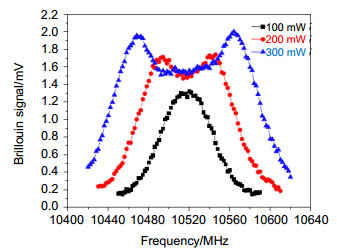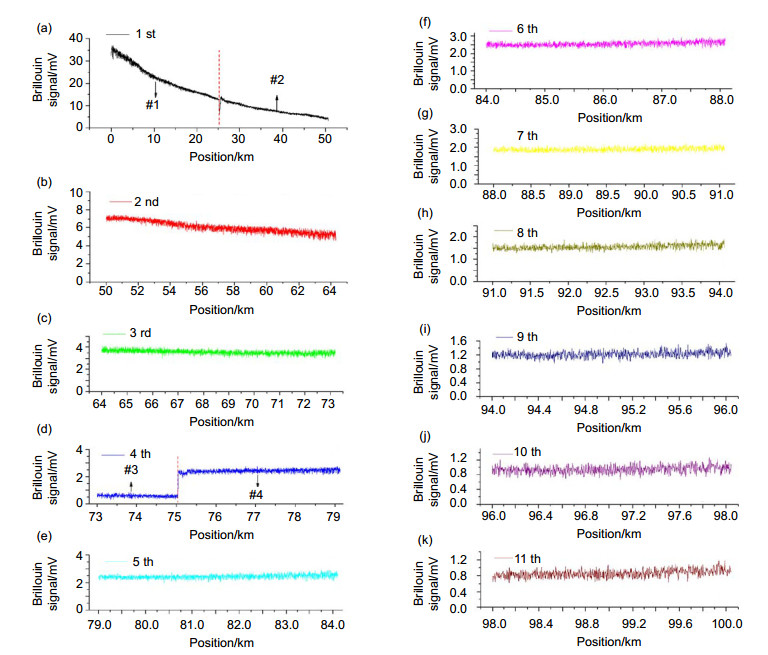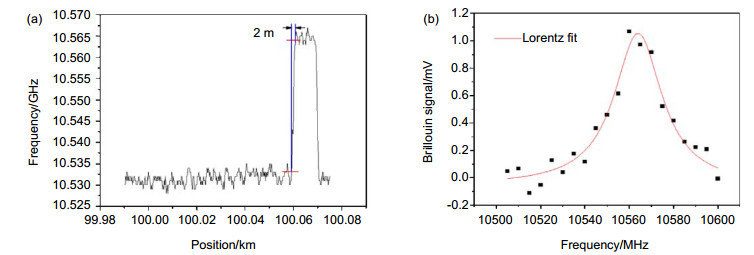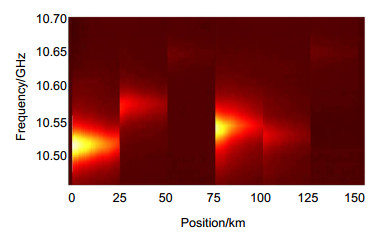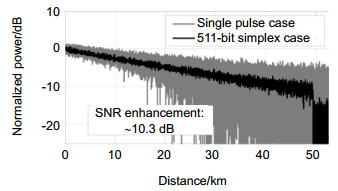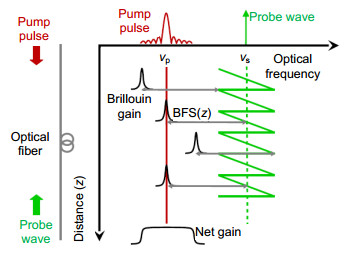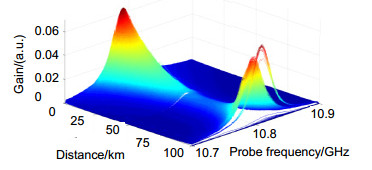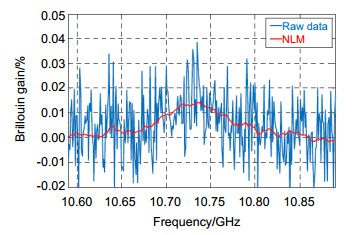Advances of key technologies in long-range distributed Brillouin optical fiber sensing
-
摘要
布里渊光纤传感通过光纤中受激布里渊散射效应实现温度和应变测量,具有空间分辨率高、传感距离长和测量精度高等特点,因此分布式布里渊光纤传感成为近年的研究热点。本文通过对长距离分布式布里渊光纤传感研究进展的调研和分析,概括了长距离布里渊传感面临的主要限制因素和解决的关键技术,重点介绍了基于时分复用、频分复用、脉冲编码、宽带频率调制和图像处理算法的长距离布里渊光纤传感技术。随着长距离布里渊光纤传感器的实际工程化,对于快速测量的需求愈发显著,这将是未来长距离布里渊光纤传感的主要研究方向。
Abstract
Brillouin fiber sensing using stimulated Brillouin scattering in fibers to measure temperature and stress with the features of high-spatial resolution, long sensing range, small measurement error, etc. Therefore, Brillouin fiber sensing becomes the hotspot in recent two or three decades. Through research and analysis on the progress of long range distributed Brillouin sensing, main limitations and key techniques are generalized in this paper. Long range sensing schemes based on time division multiplexing, frequency division multiplexing, pulse coding, wide-bandwidth frequency modulation and image processing methods are emphatically introduced here. With long range Brillouin sensors applied in practice, increasing demand for fast measurement emerges, which we believe will be dominant in the research of long range Brillouin fiber sensing in the future.
-
Overview

Overview: The distributed Brillouin optical fiber sensors have gain considerable interests, due to their capabilities of monitoring strain and temperature. The Brillouin optical time domain analysis (BOTDA) system, which is the typical representation of distributed Brillouin sensors, features high spatial resolution, long range and fast measurement. In recent years, the BOTDA sensors have been widely used in oil and gas pipelines to detect the leakage, civil structure health monitoring and cable temperature sensing. The distributed BOTDA sensors are promising tools to these and other applications that need for monitoring large distances.
However, the sensing range of BOTDA sensors is fundamentally determined by the signal to noise ratio (SNR). The continuous probe power is limited by the Brillouin threshold, while the modulation instability (MI) or the self-phase modulation (SPM) is the main obstacle to input high power pump pulse. We have systematically investigated the impact of MI and SPM on long-range BOTDA system theoretically and experimentally. Besides, the pump depletion and non-local effect is detrimental to the long-range BOTDA sensors performance.
Several impressive technologies have been proposed to extend the sensing range of BOTDA system. In 2010, the coding BOTDA is firstly proposed to increase the SNR effectively by Soto et al. Then they utilize the pre-amplification and Raman amplification to further extend the sensing range to 120 km with an accuracy of 2.2 ℃ or 44 με in 2012. In 2011, Dong et al proposed the time division BOTDA to decrease the SBS interaction range and realized a 100 km Brillouin fiber sensing. In the same vein, the frequency division combining the in-line EDFAs BOTDA achieved a 150km sensing range with a 2 m spatial resolution. In 2016, the Spanish group demonstrated a BOTDA sensor in loss configuration with the optical frequency of the probe wave modulating along the fiber. It had several advantages such as high Brillouin threshold, overcoming the non-local effect and no additional amplifier. In the same year, the Swiss team firstly utilized the image denoising and it was able to enhance the SNR 14 dB in 50 km fiber. Imaging denoising was an effective method to increase the SNR in BOTDA system with no hardware modification.
In summary, long range Brillouin sensing schemes based on time division multiplexing, frequency division multiplexing, pulse coding, wide-bandwidth frequency modulation and image denoising are introduced in this paper. With long range Brillouin sensors applied in practice, increasing demand for fast measurement emerges, which we believe will be dominant in the research of long range Brillouin fiber sensing in the future.
-

-
图 4 11段传感光纤的布里渊信号时域波形。泵浦光与探测光的频率差分别为:(a) 10.535 GHz; (b)~(c) 10.580 GHz; (d)~(k) 10.530 GHz[14]
Figure 4. Time traces of the Brillouin signal for 11 sections. The frequency offset between the probe and pump waves is locked at 10.535 MHz for (a), 10.580 MHz for (b)~(c), and 10.530 MHz for (d)~(k)[14]
-
参考文献
[1] Sun Q, Feng H, Yan X Y, et al. Recognition of a phase-sensitivity OTDR sensing system based on morphologic feature extraction[J]. Sensors, 2015, 15(7): 15179-15197. doi: 10.3390/s150715179
[2] Dong Y K, Chen X, Liu E H, et al. Quantitative measurement of dynamic nanostrain based on a phase-sensitive optical time domain reflectometer[J]. Applied Optics, 2016, 55(28): 7810-7815. doi: 10.1364/AO.55.007810
[3] Dong Y K, Xu P B, Fu C, et al. 1200℃ high-temperature distributed Brillouin optical fiber sensing based on photonics crystal fiber[J]. Proceedings of SPIE, 2015, 9634: 963485. doi: 10.1117/12.2205329
[4] Kim Y H, Song K Y. Tailored pump compensation for Brillouin optical time-domain analysis with distributed Brillouin amplification[J]. Optics Express, 2017, 25(13): 14098-14105. doi: 10.1364/OE.25.014098
[5] Bolognini G, Hartog A H. Raman-based fibre sensors: trends and applications[J]. Optical Fiber Technology, 2013, 19(6): 678-688. doi: 10.1016/j.yofte.2013.08.003
[6] Dominguez-Lopez A, Soto M A, Martin-Lopez S, et al. Resolving 1 million sensing points in an optimized differential time-domain Brillouin sensor[J]. Optics Letters, 2017, 42(10): 1903-1906. doi: 10.1364/OL.42.001903
[7] Horiguchi T, Kurashima T, Tateda M. Tensile strain dependence of Brillouin frequency shift in silica optical fibers[J]. IEEE Photonics Technology Letters, 1989, 1(5): 107-108. doi: 10.1109/68.34756
[8] Kurashima T, Horiguchi T, Tateda M. Thermal effects on the Brillouin frequency shift in jacketed optical silica fibers[J]. Applied Optics, 1990, 29(15): 2219-2222. doi: 10.1364/AO.29.002219
[9] Dong Y K, Chen L, Bao X Y. Extending the sensing range of Brillouin optical time-domain analysis combining frequency-division multiplexing and in-line EDFAs[J]. Journal of Lightwave Technology, 2012, 30(8): 1161-1167. doi: 10.1109/JLT.2011.2170813
[10] Ba D X, Wang B Z, Zhou D W, et al. Dynamic distributed Brillouin optical fiber sensing based on multi-slope analysis[J]. Proceedings of SPIE, 2015, 9634: 96344T. doi: 10.1117/12.2194539
[11] Soto M A, Bolognini G, Pasquale F D, et al. Simplex-coded BOTDA fiber sensor with 1 m spatial resolution over a 50 km range[J]. Optics Letters, 2010, 35(2): 259-261. doi: 10.1364/OL.35.000259
[12] Soto M A, Bolognini G, Di Pasquale F. Long-range simplex-coded BOTDA sensor over 120km distance employing optical preamplification[J]. Optical Letters, 2011, 36(2): 232-234. doi: 10.1364/OL.36.000232
[13] Soto M A, Taki M, Bolognini G, et al. Simplex-coded BOTDA sensor over 120-km SMF with 1-m spatial resolution assisted by optimized bidirectional Raman amplification[J]. IEEE Photonics Technology Letters, 2012, 24(20): 1823-1826. doi: 10.1109/LPT.2012.2212183
[14] Dong Y K, Chen L, Bao X Y. Time-division multiplexing-based BOTDA over 100km sensing length[J]. Optics Letters, 2011, 36(2): 277-279. doi: 10.1364/OL.36.000277
[15] Mompó J J, Urricelqui J, Loayssa A. Brillouin optical time-domain analysis sensor with pump pulse amplification[J]. Optics Express, 2016, 24(12): 12672-12681. doi: 10.1364/OE.24.012672
[16] Soto M A, Ramírez J A, Thévenaz L. Intensifying the response of distributed optical fibre sensors using 2D and 3D image restoration[J]. Nature Communications, 2016, 7: 10870. doi: 10.1038/ncomms10870
[17] Soto M A, Ramírez J, Thevenaz L. 200 km fiber-loop conventional Brillouin distributed sensor with 2 m spatial resolution using image denoising[C]//Asia Pacific Optical Sensors Conference, 2016: Th3A. 4.
[18] Dong Y K, Zhang H Y, Lu Z W, et al. Impacts of Kerr effect and fiber dispersion on long-range Brillouin optical time-domain analysis systems[J]. Proceedings of SPIE, 2012, 8421: 84219Z. doi: 10.1117/12.974984
[19] Tai K, Hasegawa A, Tomita A. Observation of modulational instability in optical fibers[J]. Physical Review Letters, 1986, 56(2): 135. doi: 10.1103/PhysRevLett.56.135
[20] Dominguez-Lopez A, Angulo-Vinuesa X, Lopez-Gil A, et al. Non-local effects in dual-probe-sideband Brillouin optical time domain analysis[J]. Optics Express, 2015, 23(8): 10341-10352. doi: 10.1364/OE.23.010341
[21] Thévenaz L, Mafang S F, Lin Jie. Effect of pulse depletion in a Brillouin optical time-domain analysis system[J]. Optics Express, 2013, 21(12): 14017-14035. doi: 10.1364/OE.21.014017
[22] Dong Y K, Chen L, Bao X Y. System optimization of a long-range Brillouin-loss-based distributed fiber sensor[J]. Applied Optics, 2010, 49(27): 5020-5025. doi: 10.1364/AO.49.005020
[23] Jia X H, Chang H Q, Lin K, et al. Frequency-comb-based BOTDA sensors for high-spatial-resolution/long-distance sensing[J]. Optics Express, 2017, 25(6): 6997-7007. doi: 10.1364/OE.25.006997
-
访问统计


 E-mail Alert
E-mail Alert RSS
RSS

 下载:
下载:
